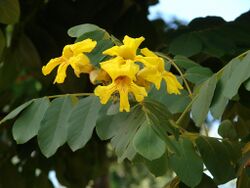Biology:Markhamia lutea
| Markhamia lutea | |
|---|---|

| |
| Blossoms of Markhamia lutea | |
| Scientific classification | |
| Kingdom: | Plantae |
| Clade: | Tracheophytes |
| Clade: | Angiosperms |
| Clade: | Eudicots |
| Clade: | Asterids |
| Order: | Lamiales |
| Family: | Bignoniaceae |
| Genus: | Markhamia |
| Species: | M. lutea
|
| Binomial name | |
| Markhamia lutea (Benth.) K.Schum.
| |
| Synonyms | |
| |
Markhamia lutea, the Nile tulip, Nile trumpet or siala tree is a tree species of the family Bignoniaceae,[2] native to eastern Africa and cultivated for its large bright yellow flowers. It is related to the African tulip tree. Native to Africa, Markhamia was named in the honour of Clements Markham (1830-1916), who worked in India. An evergreen small tree that grows to 4–5 m in height outside of native zones, although it can reach more than 10 m in its zones of origin. Leaves, of 20–30 cm in length, normally arranged in groups in the ends of the branches. Flowers in terminal clusters. They are trumpet shaped, yellow in colour, with orange-reddish spots in the throat. They measure 5–6 cm in length. Fruit is a capsule, of up to 70 cm in length, with abundant winged seeds. It is propagated by seeds.
Notes
- ↑ Botanic Gardens Conservation International (BGCI).; IUCN SSC Global Tree Specialist Group (2019). "Markhamia lutea". IUCN Red List of Threatened Species 2019: e.T144259403A149036077. doi:10.2305/IUCN.UK.2019-2.RLTS.T144259403A149036077.en. https://www.iucnredlist.org/species/144259403/149036077. Retrieved 18 November 2021.
- ↑ "Identifying Indian Trees". http://flowersofindia.net/treeid/index.html.
References
African Union (2010-03-02), List of Countries which have Signed, Ratified/Adhered, archived from the original on 2012-09-02, https://web.archive.org/web/20120902043558/http://www.africa-union.org/root/au/Documents/Treaties/List/African%20Convention%20on%20nature%20and%20natural%20resources.pdf
External links
Wikidata ☰ Q6771037 entry
 |


